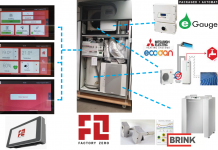Tom Konrad CFA
Contrary to common belief, the greatest barrier to the adoption of clean energy is not the cost. In many cases, cost is not a barrier at all: it’s an advantage. That’s because energy efficiency measures are usually so cost-effective that they not only pay for themselves, they can often pay for the addition of flashier clean energy technologies such as solar and wind.
For institutions in the Federal and MUSH (Municipalities, Universities, Schools, and Hospitals) sectors, the main barriers are lack of capital and expertise. Lack of capital arises because such institutions traditionally consider energy to be an operating expense, not a capital expense, while clean energy projects usually require an initial capital expenditure in return for ongoing energy savings. Lack of expertise arises simply because finding the best energy solutions is far from simple. Although there are many simple measures that an interested amateur can take, the greatest savings come from considering buildings and other facilities as integrated systems, not as collections of isolated measures.
Energy Service Companies
Ameresco, Inc. (NYSE:AMRC) was founded in 2000 as an independent, one-stop shop to help Federal and MUSH institutions overcome these barriers. Last week, I interviewed Ameresco President and CEO George Sakellaris as part of my series of articles on energy service stocks. Sakellaris pioneered this Energy Service Company (ESCO) model while working for New England Electric System to help industrial customers reduce their power usage in 1979. Before founding Ameresco, he founded another leading ESCO, Noresco in 1989, which is currently owned by Carrier, a division of United Technologies (NYSE:UTX).
I first became interested in the ESCO model (also known as performance contracting) in 2007, when I heard about it as part of a Western Governor’s Association Workshop on Efficient Buildings. Then, as now, most ESCOs are arms of larger technology companies, like Noresco mentioned above, or are part of energy companies and utilities. Other publicly traded companies with ESCO arms include AECOM (NYSE:ACM), Honeywell (NYSE:HON), Chevron (NYSE:CVX), Consolidated Edison (NYSE:ED), Constellation (NYSE:CEG), Eaton (NYSE:ETN), NextEra (NYSE:NEE), Johnson Controls(NYSE:JCI), Schneider Electric (Paris:SU.PA/SBGSF.PK), and Ingersoll-Rand (NYSE:IR).
In contrast, Ameresco is independent of any equipment manufacturer or energy company, leaving them technology-agnostic and able to approach the solution from the customer’s perspective. This independence, along with previous customer satisfaction and Ameresco’s wide expertise allows the company to win bids such as the $795 million contract to build biomass cogeneration and heating facilities at the Department of Energy’s Savannah River Site in South Carolina over the course of 19 years. According to Sakellaris, Ameresco won this contract (the largest renewable energy performance contract so far in the United States) without being the lowest cost bidder because of their expertise and independence. He also says Ameresco can compete on price because of low overhead.
Financial Results
The combination of a strong brand and expertise along with low overhead have contributed to strong results. Annual revenue has grown steadily from $278 million in 2006 to $618 million in 2010, with second quarter revenue up 17% on a year earlier, matching the last five year’s compound annual growth rate (CAGR). Over the same period, earnings per share have risen at a 21% CAGR. At the current stock price of $10.34, AMRC has a trailing P/E ratio of 14.35, which is modest considering the consensus 20% long term expected growth rate.
Ameresco also has good liquidity, with a current ratio over two. I would normally consider its Debt to Equity ratio of 1.3 a problem, but much of this debt is project debt which will be transferred to project lenders upon project completion and acceptance by the Federal government. If this project-related debt is removed from the calculation, the Debt to Equity ratio falls to a quite conservative 0.37.
Although multiple analysts reduced their price targets for Ameresco after the last conference call, the reason they gave was not any deterioration of Ameresco’s business, but rather a decline in price of most companies in the sector, meaning that most investors are no longer willing to pay as much for a dollar of earnings or revenue than they were just a few months ago.
Growth Strategy
Sakellaris told me that he plans to grow using only internal resources without taking on any more debt or issuing additional equity. Ameresco has and will continue to grow both organically and by acquisition using funds provided by operations.
In general, it makes sense to be wary of growth by acquisition in public companies, since it often leads to a lack of focus and can distract management from the core business. That seems not to be the case for Ameresco, which takes a very strategic approach to acquisitions, and only acquires firms that either can expand the range of expertise the company can offer to clients, or allow the company to enter new geographic markets, such as their recent purchase of Applied Energy Group, which allowed them to expand their offering to utility customers.
One type of company Sakellaris says they will never acquire is equipment manufacturing firms, in order to maintain the advantage of being an independent integrator of technologies from all suppliers. Nor is he interested in buying Demand Response (DR) providers such as Comverge (NASD: COMV) and Enernoc (NASD: ENOC), both of which were previously covered in this series, and whose stocks have fallen enough to look like attractive acquisition targets. Although Ameresco does provide DR as part of their offerings, it’s not a driver for their business. He sees a “conflict between energy efficiency and demand response” because properly implemented energy efficiency measures reduce the scope for DR. As he puts it, “More effective air conditioning is better than cycling air conditioning.” To be able to cycle an air conditioner off during peak times without significant thermal storage, the unit will have to be over-sized for its purpose in order to bring the building back to the expected level after the demand event is over, and over-sized units cool less efficiently.
When the company has cash but lacks acquisition targets that meet these criteria, they invest it in renewable energy projects, such as landfill gas, where they extract landfill gas, clean it, and deliver it to local customers for heat and electricity generation. These projects typically pay back the invested equity in three or four years.
Governmental entities accounted for about 86% of Ameresco’s revenues in 2009 and 2010. Sakellaris is confident that the whole ESCO industry has only penetrated about 20% of the opportunity in the sector, citing a McKinsey study which estimated the potential of this market at $520 billion of performance contracts by 2020, and the market continues to expand as new technology leads to new energy saving opportunities. The ESCO industry is doing only about six to seven billion dollars worth of contracts a year, leaving plenty of room for growth.
Company Structure
One worry I had about the company was the company’s governance. Sakellaris completely controls the company through his ownership of all of the company’s class B shares, which have privileged voting rights, as well as through his posts as President, CEO, and Chairman of the board. Purchasers of this stock are buying into Sakellaris’ vision for the company. While the board has an independent nominating committee, which Sakellaris is not on, and he says he obeys the directions of the board and would not block a candidate put forward by the nominating committee, shareholders are essentially putting faith in his self-restraint.
I came away from my conversation with Sakellaris feeling that he is a dedicated entrepreneur who wants nothing more than to make his company an extremely “successful and sustainable enterprise”, and that he was being honest when he told me that he kept voting control of the company when he took it public last year in order to be able to negotiate the best possible price in case the company is sold.
But the company will not be lost without him. Although he is 65, he is still healthy, but that has not stopped him from making sure the board has an adequate succession plan. While Ameresco has grown through acquisition, it held on to the leaders of many of the acquired companies, several of whom now run Ameresco’s divisions, and four of whom Sakellaris believes would be able to run Ameresco in his absence. Their continued presence at Ameresco does a lot to ease my worries not only about succession issues, but also gives me some assurance that Sakellaris is a good leader, since such capable people would not have stayed if he were a tyrant.
Conclusion
Ameresco seems to be a well run and sustainable company. In the short term, the ESCO business may be hurt by government spending cuts, but in the long term, budget pressure will make Ameresco’s services all the more necessary. The ESCO business model is also helped by current low interest rates, because the lower the interest rate, the more energy efficiency and renewable energy measures become economic, and the more business Ameresco can do for a single client.
Although Ameresco is not nearly as cheap in terms of assets as some of the other energy services firms covered in this series, it is more profitable, and a decent value given its earnings and growth prospects. I recently bought shares in the low $10 range, and will be looking to acquire more if the broad market implosion makes this current good value an absolute bargain.
Thanks to Rafael Coven of the Cleantech Index, Jeff Cianci of Green Science Partners, and Garvin Jabusch of Green Alpha Advisors, for contributing to my research for this article.
DISCLOSURE: Long AMRC, COMV, ENOC.
DISCLAIMER: Past performance is not a guarantee or a reliable indicator of future results. This article contains the current opinions of the author and such opinions are subject to change without notice. This article has been distributed for informational purposes only. Forecasts, estimates, and certain information contained herein should not be considered as investment advice or a recommendation of any particular security, strategy or investment product. Information contained herein has been obtained from sources believed to be reliable, but not guaranteed.








